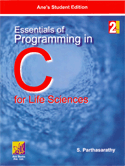
|
Essentials of Programming in C for Life Sciences , 2nd ed. - S. Parthasarathy |
|
|
Cover Price : Rs 210.00
|
Imprint : Ane Books Pvt. Ltd.
ISBN : 9381162088
YOP : 2011
|
Binding : Paperback
Total Pages : 250
CD : No
|
|
About the Book :-
This book provides a standard text on programming in C for both the undergraduate and postgraduate students and also research scientists of life sciences, who would like to acquire programming skills and write simple programs in C. This book does not assume any prior knowledge of computers or programming and hence, it introduces all the basic concepts starting from the Introduction to Computers and Fundamentals of C along with all the salient features of C namely, Control statements, Functions, Pointers, Structures, Unions, and Data Files in C.
The concepts of programming in C are explained keeping in mind the students and research scientists of life sciences. As most of the students of life sciences stream may be less comfortable with mathematical and computational examples, they must be introduced to programming by using simple examples taken from biological sciences. The concepts of programming in C are presented in a simple and easy way to understand through examples taken from both general and Life Sciences, which may kindle interest to learn computer programming to the readers. Written in a self explanatory manner, any student or research scientist of life sciences will be comfortable in learning programming from this book, which will also serve as a very good resource for the teachers.
Salient Features :-
Provides a standard text on programming in C • Does not assume any prior knowledge of computers and programming • Introduces all the basic concepts of computers and programming • Written in a self-explanatory manner • Programming examples are taken from both general and Life Sciences • Contains more than 85 complete computer program C source codes • Forms a good resource for the students, researchers and teachers.
Contents :-
1. Introduction to Computers 2. Fundamentals of C 3. Control Statements In C 4. Functions in C 5. Pointers in C 6. Structures And Unions in C 7. Data Files in C , 8. Additional Programming Examples, Appendices, References, Index
About the Author :-
Dr. S. Parthasarathy obtained his Master's Degree in Physics from St. Joesph's College, Tiruchirappalli and M. Phil. and Ph.D. degrees from Bharathidasan University, Tiruchirappalli. He has worked in several premier institutions like CCMB, Hyderabad, NAL, Bangalore, ICGEB, Trieste, Italy, and National Institute of Technology (Formerly REC), Tiruchirappalli. He has also worked for Monsanto Research Center, Bangalore, which is a research center of the Monsanto Enterprises Ltd., St. Louis, USA.
Dr. Parthasarathy is currently the Head of the Department of Bioinformatics, School of Life Sciences, Bharathidasan University, Tiruchirappalli. His research interests are Biological Sequence and Structure Analysis, Bioinformatics Software Tool Development, Chaos Game Representation of Protein Sequences, and Protein Fold Recognition. He has published more than twenty five research papers in reputed international journals. He has a vast experience in programming and developed many programs for his research and teaching. He has been teaching programming in C and C++ for several heterogeneous groups of students for more than a decade.
Dr. Parthasarathy brings a new simplified approach in learning computer programming in C for the students and scientists of Life Sciences. This book can be used as a text book for computer programming courses for Life Sciences, Biomedical Sciences, Pharmaceutical Sciences and Agricultural Sciences at university level both in India and abroad.
|
|
 |
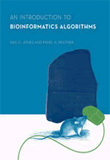
|
An Introduction to Bioinformatics Algorithms - Neil C Jones |
Author |
Neil C Jones
Pavel A Pevzner
|
|
Cover Price : Rs 2,495.00
|
Imprint : MIT Press
ISBN : 9788119160587
YOP : 2023
|
Binding : Hardbound
Total Pages : 456
CD : No
|
|
DESCRIPTION
This introductory text offers a clear exposition of the algorithmic principles driving advances in bioinformatics. Accessible to students in both biology and computer science, it strikes a unique balance between rigorous mathematics and practical techniques, emphasizing the ideas underlying algorithms rather than offering a collection of apparently unrelated problems.
The book introduces biological and algorithmic ideas together, linking issues in computer science to biology and thus capturing the interest of students in both subjects. It demonstrates that relatively few design techniques can be used to solve a large number of practical problems in biology, and presents this material intuitively.
An Introduction to Bioinformatics Algorithms is one of the first books on bioinformatics that can be used by students at an undergraduate level. It includes a dual table of contents, organized by algorithmic idea and biological idea; discussions of biologically relevant problems, including a detailed problem formulation and one or more solutions for each; and brief biographical sketches of leading figures in the field. These interesting vignettes offer students a glimpse of the inspirations and motivations for real work in bioinformatics, making the concepts presented in the text more concrete and the techniques more approachable.
ABOUT THE AUTHOR
Neil C. Jones is a Ph.D. candidate in the Department of Computer Science and Engineering at the University of California, San Diego.
Pavel Pevzner is Ronald R. Taylor Professor of Computer Science at the University of California, San Diego. He is the author of Computational Molecular Biology: An Algorithmic Approach (MIT Press, 2000).
CONTENTS
1. Introduction
2 Algorithms and Complexity
3 Molecular Biology Primer
4 Exhaustive Search
5 Greedy Algorithms
6 Dynamic Programming Algorithms
7 Divide-and-Conquer Algorithms
8 Graph Algorithms
9 Combinatorial Pattern Matching
10 Clustering and Trees
11 Hidden Markov Models
12 Randomized Algorithms
Using Bioinformatics Tool
Bibliography
Index.
|
|
 |
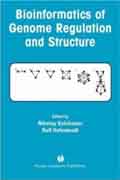
|
Bioinformatics of Genome Regulation and Structure - Nikolay Kolchanov |
Author |
Nikolay Kolchanov
Ralf Hofestaedt
|
|
Cover Price : Rs 895.00
|
Imprint : Springer
ISBN : 8181283775
YOP : 2005
|
Binding : Paperback
Total Pages : 392
CD : No
|
|
DESCRIPTION
Bioinformatics of Genome Regulation and Structure covers:
-regulatory genomic sequences: databases, knowledge bases, computer analysis, modeling, and recognition;
-large-scale genome analysis and functional annotation;
-gene structure detection and prediction;
-comparative and evolutionary genomics;
-computer analysis of genome polymorphism and evolution; computer analysis and modeling of transcription, splicing, and translation; structural computational biology: structure-function organization of genomic DNA, RNA, and proteins;
-gene networks, signal transduction pathways, and genetically controlled metabolic pathways: principles of organization, operation, and evolution;
-data warehousing, knowledge discovery and data mining; and,
-analysis of basic patterns of genome operation, organization, and evolution.
The data presented may be used while solving a wide range of problems, both basic and applied, in various directions of molecular biology, molecular genetics, biotechnology, pharmacogenetics, pharmacology, and adjacent fields of medicine, veterinary, and agrobiology.
WRITTEN FOR
Researchers, scientists in biology, molecular genetics, biotechnology, pharmacogenetics, pharmacology, and adjacent fields of medicine, veterinary, and agrobiology. |
|
 |
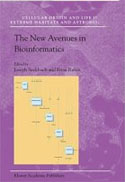
|
The New Avenues in Bioinformatics - Joseph Seckback |
Author |
Joseph Seckback
Eitan Rubin
|
|
Cover Price : Rs 695.00
|
Imprint : Springer
ISBN : 8181285441
YOP : 2007
|
Binding : Paperback
Total Pages : 304
CD : No
|
|
DESCRIPTION
Bioinformatics has ignited the imagination of scientists, entrepreneurs and the general public. At the meeting place of two fast growth disciplines, biology and computer science Bioinformatics is one of the cornerstones of the new biology. It is clearly pivotal to the translation of high throughput projects such the human genome project into useful knowledge. Yet despite all this attention, there is no consensus on what exactly is Bioinformatics. There are several canonical topics, such as gene structure prediction, protein functional classification or structure prediction. The present book explores new frontiers in bioinformatics, such as Glycomics or the computational modeling of genetic processes. We also discuss confounding factors that we find crucial to the development of the field, such as the ability to protect and restrict intellectual property in the field, or the challenges involved in educating bioinformatics users. Finally, we touch upon some fundamental questions, such as what information is and how it is captured in biological systems. By bringing to the readers such a broad spectrum of reviews, we hope to capture the vibrant spirit of this young science and to truly represent the fast pace with which it is still developing.
CONTENTS
Dedication
Acknowledgements
Authors List
Glossary
Biodata of the editors
Part I. Opening
Part II. Overview & Origin of Information
Part III. Biological Biodata, Evolutionary Data & Chirality
Part IV. Genes & Genetics
Part V. Glycoinformatics & Protein Data
Part VI. Education & Legal Aspects
Part VII. Additional Links
Index
Index of Authors. |
|
 |
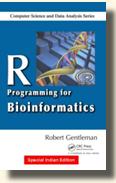
|
R Programming for Bioinformatics - Robert Gentleman |
|
|
Cover Price : Rs 2,995.00
|
Imprint : CRC Press
ISBN : 9781498797733
YOP : 2016
|
Binding : Hardbound
Total Pages : 328
CD : No
|
|
DESCRIPTION
Covers the fundamentals of the R language and object-oriented programming in R
Discusses XML, SOAP, and other data mark-up and web services languages and tools
Deals with many of the standard sequence similarity tools that play a prominent role in computational biology
Explores the interaction of R with other languages, such as C, FORTRAN, Perl, and Python
Explains how to write your own software packages and how to debug and profile R code
Contains complete source code on the book’s website
Summary
Due to its data handling and modeling capabilities as well as its flexibility, R is becoming the most widely used software in bioinformatics. R Programming for Bioinformatics explores the programming skills needed to use this software tool for the solution of bioinformatics and computational biology problems.
Drawing on the author’s first-hand experiences as an expert in R, the book begins with coverage on the general properties of the R language, several unique programming aspects of R, and object-oriented programming in R. It presents methods for data input and output as well as database interactions. The author also examines different facets of string handling and manipulations, discusses the interfacing of R with other languages, and describes how to write software packages. He concludes with a discussion on the debugging and profiling of R code.
With numerous examples and exercises, this practical guide focuses on developing R programming skills in order to tackle problems encountered in bioinformatics and computational biology.
CONTENTS
Introducing R
Motivation
A note on the text
R Language Fundamentals
Data structures
Managing your R session
Language basics
Subscripting and subsetting
Vectorized computations
Replacement functions
Functional programming
Writing functions
Flow control
Exception handling
Evaluation
Lexical scope
Graphics
Object-Oriented Programming in R
The basics of OOP
S3 OOP
S4 OOP
Using classes and methods in packages
Documentation
Debugging
Managing S3 and S4 together
Navigating the class and method hierarchy
Input and Output in R
Basic file handling
Connections
File input and output
Source and sink: capturing R output
Tools for accessing files on the Internet
Working with Character Data
Built-in capabilities
Regular expressions
Prefixes, suffixes and substrings
Biological sequences
Matching patterns
Foreign Language Interfaces
Calling C and FORTRAN from R
Writing C code to interface with R
Using the R API
Loading libraries
Advanced topics
Other languages
R Packages
Package basics
Package management
Package authoring
Initialization
Data Technologies
Using R for data manipulation
Example
Database technologies
XML
Bioinformatics resources on the WWW
Debugging and Profiling
The browser function
Debugging in R
Debugging C and other foreign code
Profiling R code
Managing memory
References
An Introduction appears at the beginning of each chapter.
Reviews
"This is a very excellent book. … I think this is actually the best handbook on R programming that is currently available. … the nine chapters provide an indispensable handbook for R programmers, and an excellent textbook for a graduate course in R programming."
—Journal of Statistical Software |
|
 |

|
Essentials of Modern Biology - R. C. Sobti |
Author |
R. C. Sobti
V. L. Sharma
|
|
Cover Price : Rs 395.00
|
Imprint : Ane Books Pvt. Ltd.
ISBN : 8180521389
YOP : 2009
|
Binding : Paperback
Total Pages : 728
CD : No
|
|
DESCRIPTION
Modern Biology has its foundations in the study of basic phenomena of life without which the intricacies of life are impossible to understand. Good understand of basic biology is a prerequisite to develop new technologies, to work with them and use them for our benefits.
This book on "Modern Biology” has been compiled to help the students particularly those with non-medical background opting for courses on bioengineering, bioinformatics, biomedical engineering etc. It encompasses the topics on basics of biology covering origin of life, evolution, cellular organization, classification of living organisms, human biology, genetics, microbiology etc. An attempt has been made to compile reasonable information regarding these varied topics to enable the students to get conversant with the basic aspects of life.
This will be a ready reference for both the teacher and the student. Although every case has been taken to give correct and up-to-date information, there may however be certain lacunae which can only be plugged with the feedback which we modestly expect to be coming from the readers.
CONTENTS
Preface, 1. General Biology, 2. Cell Biology, 3. Introduction to Life Sciences: Botany and Zoology, 4. Major Taxa in Plants, 5. Major Taxa in Animals, 6. Forms and Functions of Systems in Plants, 7. Forms and Functions of Animals, 8. Introduction to Human Biology, 9. Microbiology : History of Microbioloy & Classification of Microorganisms, 10. Microbiology II : Diversity of Microorganisms, 11. Basics of Genetics and Evolution, 12. Basic Molecular Biology I : Nucleic Acids, 13. Basic Molecular Biology II : Proteins, Multiple Choice Questions, References, Index.
ABOUT THE AUTHORS
Dr. R.C. Sobti M.Sc. (Hons. School) First class First, Ph.D, Professor in Department of Biotechnology formerly in the Department of Zoology in Punjab University is recipient of many national and international recognitions. He is fellow of prestigious National Academy of Medical Sciences, National Academy of Sciences, Zoological Association of India and International Union Against Cancer, Geneva. He has published more than 175 papers in the journals of International repute. He has also published 16 books, four of which have been published by International publishers. He has worked in many laboratories in USA, Germany, England, Netherlands and Japan. His area of interest is molecular biology cancer biology in particular, environmental biology and biotechnology in general.
Dr. (Mrs.) Vijay Lakshmi Sharma 1 class first in M.Sc. (Hons. School) in Zoology obtained her Doctorate degree in the area of cytogenetics. Soon after, getting Ph.D., she joined as lecturer in the Department of Zoology, Punjabi University, Patiala and was promoted as a Reader. In year 1999, she shifted to the Punjab University, Chandigarh. Her area of interest is Cell Biology, Cytogenetics in particular and has published more than 30 papers in the Journals of National and International repute and have contributed two Chapters in the book on “Some Aspects of Structure and Function of Chromosome” published by M/s Kluwers Netherlands. She has also contributed Chapters in a volume “Divergent Dimensions of Environment”. Dr. (Mrs.) Sharma has published two books on the Modern Area of Life Sciences to cater to the need of the students particularly from non-medical stream.
|
|
 |
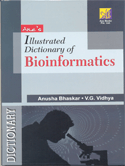
|
Ane's Illustrated Dictionary of Bioinformatics - Anusha Bhaskar |
Author |
Anusha Bhaskar
V.G. Vidhya
|
|
Cover Price : Rs 595.00
|
Imprint : Ane Books Pvt. Ltd.
ISBN : 9380156359
YOP : 2010
|
Binding : Hardbound
Total Pages : 162
CD : No
|
|
About the Book
The major advances in the field of molecular biology has led to the exploration of biological information and has thus forced the requirement of Bioinformatics to store organize retrieve and use this data.
It now entails the creation and advancement of databases, algorithms, computational and statistical techniques, and theory to solve formal and practical problems arising from the management and analysis of biological data. The primary aim of Bioinformatics is to increase our understanding of biological processes. This book is a comprehensive collection of such data, terms and techniques useful to all concerned in the field of Bioinformatics.
About the Authors
Dr. Anusha Bhaskar, Principles, Dhanalakshmi Srinivasan College of Arts and Science for Women, Perambalur, Trichy, obtained her doctorate degree in Medical Biochemistry from the University of Madras. She obtained her UG, PG and M.Phil degrees also from the same University and was ranked first in both UG and PG degree. She has more than 13 years of teaching experience in the field of Biochemistry, Biotechnology and Bioinformatics. She has published many research articles in various National and International Journals. She has also submitted a number of gene sequences to the Genebank. She has guided a number of M.Phil and Ph.D.Scholars.
V.G.Vidhya, Lecturer, Department of Biotechnology, Faculty of Science and Humanities, SRM University, Kattankulathur, Chennai obtained her PG, PGDBI and M.Phil degrees from Bharathidasan University, Trichy. She is currently pursuing her Ph.D. in Biotechnology in same University. She has published many research articles in various National and International Journals. She has also submitted a number of gene sequences to the Genebank
|
|
 |
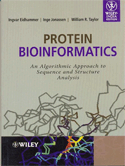
|
Protein Bioinformatics - Ingvar Eidhammer |
Author |
Ingvar Eidhammer
Inge Jonassen
William R. Taylor
|
|
Cover Price : Rs 895.00
|
Imprint : John Wiley & Sons
ISBN : 8126522729
YOP : 2009
|
Binding : Paperback
Total Pages : 373
CD : No
|
|
About the Book
Bioinformatics is the study of biological information and biological systems- such as of the relationships between the sequence, structure and function of genes and proteins. The subject has seen tremendous development in recent years, and there are ever-increasing needs for good understanding of quantitative methods in the study of proteins. Protein Bioinformatics: An algorithmic Approach to Sequence and Structure Analysis takes the novel approach of covering both the sequence and structure analysis of proteins in one volume and from and algorithmic perspective.
• Provides a comprehensive introduction to the analysis of protein sequences and structures.
• Provides an integrated presentation of methodology, examples, exercises and applications.
• Emphasises the algorithmic rather than mathematical aspects of the methods described.
• Covers comparison and alignment of protein sequences and structures as well as protein structure prediction focusing on threading approaches.
• Written in an accessible yet rigorous style, suitable for biologists, mathematicians and computer scientists alike.
• Suitable both for developers and users of bioinformatics tools.
• Supported by a Web site featuring exercises, solutions, images, and computer programs.
Protein Bioinformatics: An Algorithmic Approach to Sequence and Structure Analysis is ideally suited for advanced undergraduate and graduate students of bioinformatics, statistics, mathematics and computer science. It also provides an excellent introduction and reference source on the subject for practitioners and researchers.
Contents
Part I - Sequence Analysis
1. Pairwise Global Alignment of Sequences
2. Pairwise Local Alignment and Database Search
3. Statistical Analysis
4. Multiple Global Alignment and Phylogenetic Trees
5. Scoring Matrices
6. Profiles
7. Sequence Patterns
Part II - Structure Analysis
8. Structures and Structure Descriptions
9. Superposition and Dynamic Programming
10. Geometric Techniques
11. Clustering: Combining Local Similarities
12. Significance and Assessment of Structure Comparisons
13. Multiple Structure Comparison
14. Protein Structure Classification
Part III - Sequence-Structure Analysis
15. Structure Prediction: Threading
Appendix A Basics in Mathematics, Probability and Algorithms
Appendix B Introduction to Molecular Biology
References
Index
About the Authors
Ingvar Eidhammer & Inge Jonassen Department of Informatics, University of Bergen, Norway
William R.Taylor Division of Mathematical Biology, National Institute for Medical Research, London, UK
|
|
 |
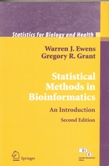
|
Statistical Methods in Bioinformatics 2nd ed. - Warren J.Ewens |
Author |
Warren J. Ewens
Gregory R. Grant
|
|
Cover Price : Rs 795.00
|
Imprint : Springer
ISBN : 9788181285027
YOP : 2008
|
Binding : Paperback
Total Pages : 618
CD : No
|
|
Advances in computers and biotechnology have had a profound impact on biomedical research, and as a result complex data sets can now be generated to address extremely complex biological questions. Correspondingly, advances in the statistical methods necessary to analyze such data are following closely behind the advances in data generation methods. The statistical methods required by bioinformatics present many new and difficult problems for the research community.
This book provides an introduction to some of these new methods. The main biological topics treated include sequence analysis, BLAST, microarray analysis, gene finding, and the analysis of evolutionary processes. The main statistical techniques covered include hypothesis testing and estimation, Poisson processes, Markov models and Hidden Markov models, and multiple testing methods.
The second edition features new chapters on microarray analysis and on statistical inference, including a discussion of ANOVA, and discussions of the statistical theory of motifs and methods based on the hypergeometric distribution. Much material has been clarified and reorganized.
The book is written so as to appeal to biologists and computer scientists who wish to know more about the statistical methods of the field, as well as to trained statisticians who wish to become involved with bioinformatics. The earlier chapters introduce the concepts of probability and statistics at an elementary level, but with an emphasis on material relevant to later chapters and often not covered in standard introductory texts. Later chapters should be immediately accessible to the trained statistician. Sufficient mathematical background consists of introductory courses in calculus and linear algebra. The basic biological concepts that are used are explained, or can be understood from the context, and standard mathematical concepts are summarized in an Appendix. Problems are provided at the end of each chapter allowing the reader to develop aspects of the theory outlined in the main text.
CONTENTS
Preface
Probability Theory: One Random Variable
Probability Theory: Many Random Variables
Statistics: An Introduction to Statistical Inference
Stochastic Processes: Poisson Processes and Markov Chains
The Analysis of Multiple DNA or Protein Sequence
Stochastic Processes: Random Walks
Statistics: Classical Estimation Theory
Statistics: Classical Hypothesis Testing Theory
BLAST
Stochastic Processes: Markov Chains
Hidden Markov Models
Gene Expression, Microarrays, and Multiple Testing
Evolutionary models
Phylogenetic Tree Estimation
Appendix A Basic Notions in Biology
Appendix B Mathematical Formulae and Results
Appendix C Computational Aspects of the Binomial and Generalized Geometric Distribution Functions
Appendix D BLAST: Sums of Normalized Scores
References
Author Index
Subject Index
Warren J. Ewens holds the Christopher H. Brown Distinguished Professorship at the University of Pennsylvania. He is the author of two books, Population Genetics and Mathematical Population Genetics. He is a senior editor of Annals of Human Genetics and has served on the editorial boards of Theoretical Population Biology, GENETICS, Proceedings of the Royal Society B and SIAM Journal in Mathematical Biology. He is a fellow of the Royal Society and the Australian Academy of Science.
Gregory R. Grant is a senior bioinformatics researcher in the University of Pennsylvania Computational Biology and Informatics Laboratory. He obtained his Ph.D. in number theory from the University of Maryland in 1995 and his Masters in Computer Science from the University of Pennsylvania in 1999.
Comments on the first edition:
"This book would be an ideal text for a postgraduate course…[and] is equally well suited to individual study…. I would recommend the book highly." (Biometrics)
"Ewens and Grant have given us a very welcome introduction to what is behind those pretty [graphical user] interfaces." (Naturwissenschaften)
"The authors do an excellent job of presenting the essence of the material without getting bogged down in mathematical details." (Journal American Statistical Association)
"The authors have restructured classical material to a great extent and the new organization of the different topics is one of the outstanding services of the book." (Metrika)
|
|
 |
|